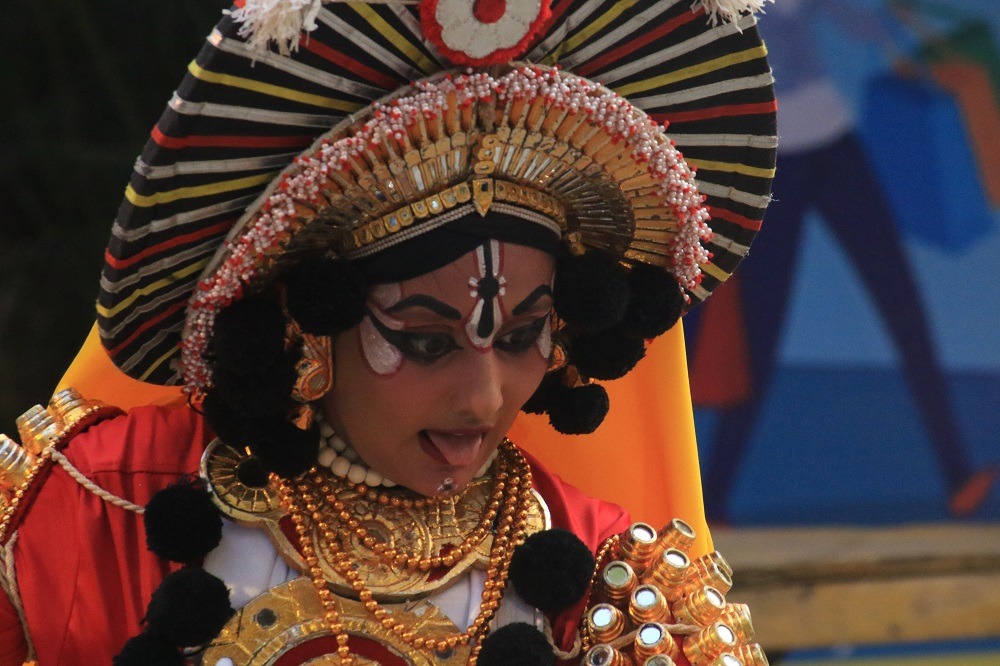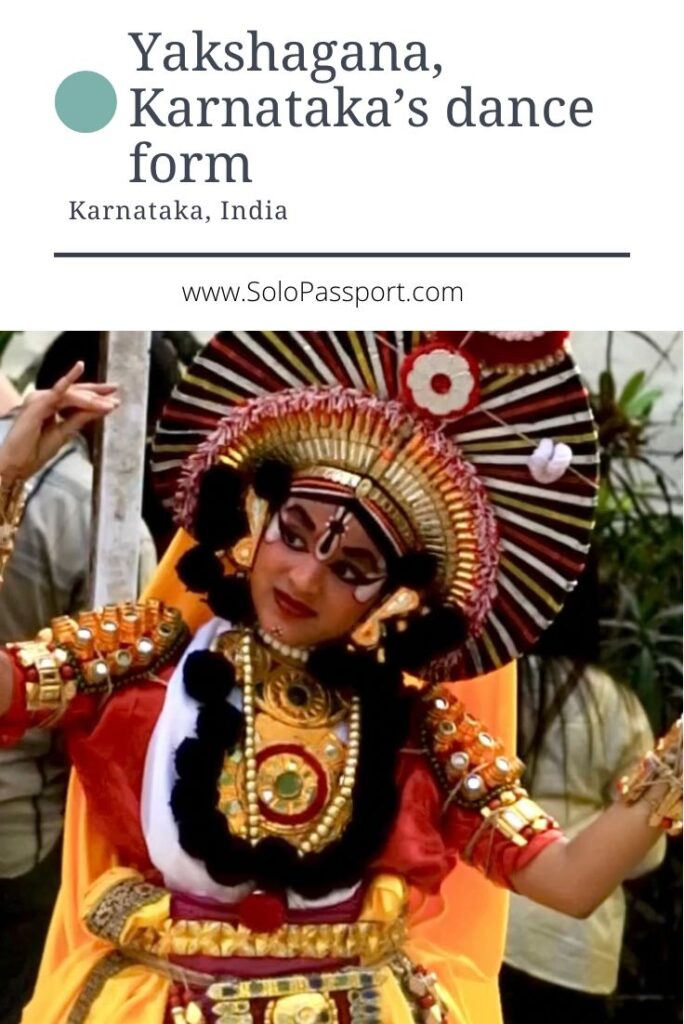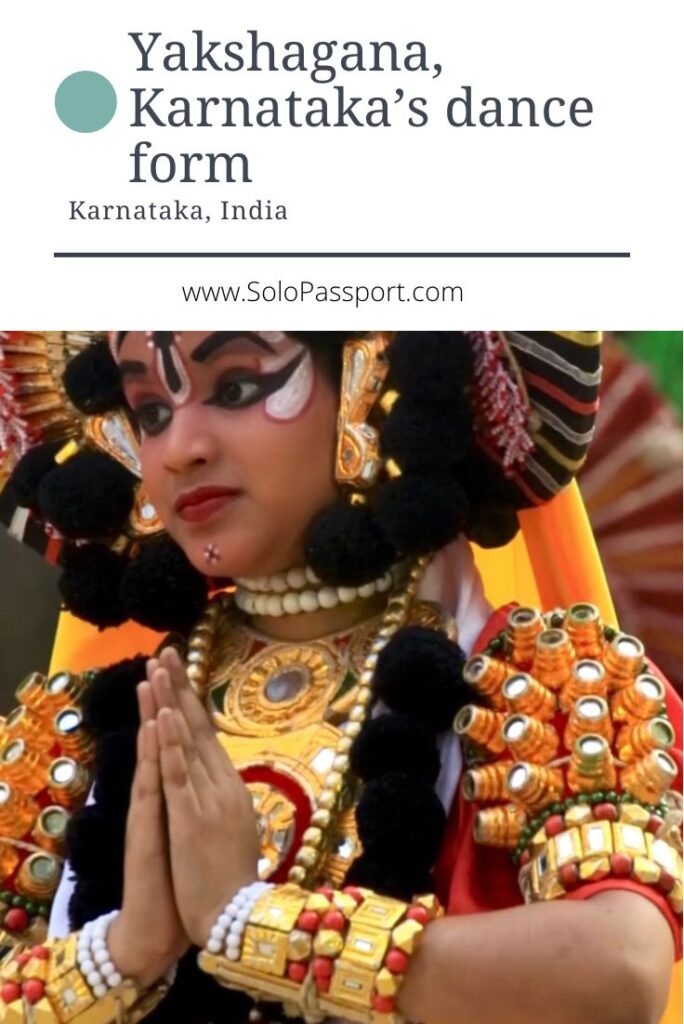Yakshagana, Karnataka’s Dance Form (2024)
Are you drawn to cultural dance forms and traditional arts? Do you appreciate the timeless beauty of ancient dances and dramas? If so, Yakshagana, a revered traditional dance form from Karnataka in India, deserves a place on your must-see list. Blending the elements of dance and theatre, Yakshagana offers a captivating spectacle that transports audiences to the heart of Indian folklore and mythology. Experience the allure of Yakshagana face painting, Karnataka’s traditional dance form enriched with intricate details. Immerse yourself in the vibrant colours and intricate patterns adorning the performers’ faces, each stroke conveying tales of ancient epics.
In this article, I aim to introduce you to the enchanting world of Yakshagana while providing insights into where you can witness live performances of this mesmerizing art form.
Having always harboured a desire to experience a live Yakshagana performance, I regretted that I had yet to witness this cultural gem firsthand despite being born in Karnataka. Therefore, when I stumbled upon a newspaper advertisement announcing a Yakshagana performance at the Karnataka Chitra Kala Parishad, I promptly RSVP’d and eagerly anticipated my visit.
Page Contents
PIN for later reference – Karnataka’s Dance Form: Yakshagana Face Painting and Dance Drama
This article may contain affiliate links, meaning if you decide to purchase via my links, I may earn a commission at no additional cost to you. For complete information, please see our affiliate disclaimer here.
Disclaimers:
- The prices mentioned in the post are valid only at the time of publication. Ensure that you check the booking websites for up-to-date information and prices.
- My opinions and views are unbiased. If the post is a collaboration, then they are specifically mentioned.
- Ensure that you check the relevant websites for up-to-date information on COVID protocols.
- For any adventurous activities, please note that there is a risk that can be dangerous. Ensure you read the terms and conditions recommended by individual agencies and do them at your own risk.
- For visas, it is best to see the embassy website for changing rules.
- While using the recommended guides, auto-drivers or taxi drivers, do your due diligence and trust your judgement.
About Yakshagana
Yakshagana, a distinctive blend of dance and drama, holds a special place in Karnataka’s cultural landscape, particularly in Coastal Karnataka. This traditional folk art form features elaborate costumes, dramatic makeup, musical compositions, dance sequences, and dialogues, creating a mesmerizing spectacle for its audience.

Referred to by various names such as Aata (meaning “play” in Kannada), Thenku Thittu, or Badaga Thittu, Yakshagana typically unfolds over an entire day, stretching from dusk to dawn, or as a night-long event. Traditionally staged in open-air theatres or temple premises, modern renditions of Yakshagana have condensed performances to approximately three hours.
The term “Yakshagana” originates from the combination of “Yaksha,” denoting celestial beings or nature spirits, and “Gana,” meaning music. This evocative name encapsulates the essence of Yakshagana, reflecting its divine and enchanting nature.
History of Yakshagana
Yakshagana debuted in Udupi under the patronage of Naraharitirtha, a Kalinga Kingdom minister and a Madhvacharya disciple. Scholars believe its origins can be traced back to the 11th and 16th centuries C.E.
The earliest written documentation of Yakshagana surfaced in 1556 C.E. and was discovered in an inscription at the Lakshminarayana Temple in Kurugodu, Bellary District. Additionally, a palm leaf manuscript found in Brahmavara (formerly Ajapura) bears a poetic composition authored by Ajapura Vishnu, further corroborating its historical roots.
Yakshagana, as it is practised today, bears the imprint of the Bhakti movement, witnessing the infusion of new compositions and the evolution of performance formats. This era saw the emergence of tent performances and the transition to ticketed events. Over time, Yakshagana has diversified into numerous variants and sub-genres, reflecting its enduring legacy and adaptability.
Yakshagana Performances
Yakshagana performances are intricate productions by a team of skilled artists, typically comprising 15 to 20 members. Traditionally, these ensembles were exclusively male-dominated, but contemporary teams now often include female artists as well.
The performance group is structured into four main components:
- Himmela: This group focuses on musical accompaniment, led by the principal vocalist known as the Bhagawatha.
- Mummela: Comprising artists responsible for dialogue delivery and narration.
- Musical Instrument Players: Members who handle the various musical instruments integral to the performance.
- Stage Performers: Actors who bring the story to life through their enactments on stage.
Music in Yakshagana is deeply rooted in ragas, with each performance intricately weaving a narrative drawn from mythological epics like the Ramayana and Mahabharata. The acting style is characterized by methodical precision, enhancing the storytelling experience. Beyond these epics, artists also portray tales from Hindu mythology, including those centered on deities such as Lord Ganesha and Goddess Chamundeshwari. Notably, performances customarily commence and conclude with acts dedicated to invoking Lord Ganesha’s blessings.
Interestingly, in the early 20th century, Yakshagana found its way into Karnataka’s school curriculum, ensuring its preservation and propagation among future generations.
Components of Yakshagana
Yakshagana, a captivating theatrical art form, comprises several essential elements harmoniously woven to craft a mesmerizing performance.
- Raga: Central to Yakshagana’s musical tapestry, ragas are melodic modes composed of five or more musical notes. They provide the foundational structure for the musical compositions, lending depth and emotion to the performance.
- Tala: Dictating the rhythmic framework of the performance, tala determines the tempo and timing for dancers and performers on stage. This rhythmic foundation ensures synchronization and coherence throughout the enactment.
- Prasanga and Literature: The heart of Yakshagana lies in its rich repertoire of prasangas, which are collections of poems meticulously crafted to form compelling plays and dramas. With over 300 prasanga books circulating today, Yakshagana boasts a vast reservoir of literary material.
- Costumes and Ornaments: Yakshagana’s visual splendour is accentuated by its vibrant, bold, and colourful costumes and ornaments. These elaborate attire and accessories not only adorn the performers but also enhance the aesthetic appeal of the production, immersing the audience in the theatrical experience.
- Musical Instruments: Integral to the musical accompaniment, Yakshagana features a diverse array of traditional instruments, including the Maddale (similar to the Mridangam), Taala (bells), and Chande (drum). The rhythmic patterns of the Taala are meticulously tuned to complement the lead singer’s voice, creating a harmonious blend of melody and rhythm.
Together, these components shape the enchanting world of Yakshagana, captivating audiences with its melodic intricacies, rhythmic cadences, literary depth, visual amenity, and soul-stirring performances.
Yakshagana Face Painting
Yakshagana, the vibrant traditional dance drama of Karnataka, is renowned for its captivating performances and elaborate and distinctive face painting. In this immersive art form, performers’ faces are transformed into intricate canvases that vividly depict the characters they portray, adding depth and visual richness to the storytelling.
The practice of face painting in Yakshagana is deeply rooted in tradition and symbolism, with each design serving as a reflection of the character’s personality, social status, and mythological significance. From gods and goddesses to demons and celestial beings, every character is brought to life by meticulously applying vibrant colours and intricate patterns.
The process of Yakshagana face painting begins long before the performance, as artists meticulously plan and design the makeup for each character. Traditionally, natural materials such as rice flour, vegetable dyes, and plant extracts were used to create the vivid hues needed for the intricate designs. However, modern cosmetic products have replaced many of these traditional materials, allowing for greater precision and durability.
One of the most iconic elements of Yakshagana face painting is the use of bold colours and exaggerated features to convey the essence of each character. For instance, gods and goddesses are often adorned with radiant hues of gold and silver, while demons and evil spirits are depicted with darker shades and menacing features. The intricate patterns and designs further enhance the character’s portrayal, with each brush stroke contributing to the performance’s overall narrative.
In addition to enhancing the visual appeal of the characters, Yakshagana face painting also serves a practical purpose on stage. The elaborate designs help distinguish between different characters, allowing audience members to identify protagonists, antagonists, and supporting roles efficiently. This clarity is essential in Yakshagana, where performers often play multiple characters throughout a single performance.

Furthermore, Yakshagana face painting is steeped in symbolism and tradition, with certain colours and designs carrying specific meanings and connotations. For example, red is often associated with bravery and heroism, while black symbolizes evil and darkness. By incorporating these symbolic elements into their designs, Yakshagana artists infuse their performances with layers of cultural significance and depth.
Beyond its aesthetic and symbolic value, Yakshagana face painting also plays a crucial role in preserving and passing down traditional art forms from one generation to the next. Many Yakshagana artists learn the art of face painting from a young age, honing their skills through years of practice and apprenticeship. In this way, the tradition of Yakshagana face painting continues to thrive, ensuring that this ancient art form remains integral to Karnataka’s cultural heritage for generations to come.
Places to See Yakshagana
Yakshagana holds a prominent place in the cultural landscape of the coastal region of Karnataka, with regular performances enchanting audiences in locales such as Udupi, South Canara, and North Canara. In recent years, the cultural capital of Bangalore has also emerged as a hub for showcasing these captivating performances, particularly at cultural fairs and events.
For those eager to experience the magic of Yakshagana firsthand, here are some reliable sources to stay informed about upcoming performances:
- Local Newspapers and Media: Keep an eye on local newspapers and media outlets, where you’ll find ample marketing and announcements regarding scheduled performances.
- Social Media Platforms: Explore Facebook groups, events, and fairs for information on local Yakshagana performances. Events are regularly updated based on selected locations, offering a convenient way to stay in the loop.
- Yakshagana Kendra Udupi Facebook Page: Stay connected with the official Facebook page of Yakshagana Kendra Udupi for updates on training programs, performances, and cultural events.
- Troupes and Tours: Follow Yakshagana troupes and artists who embark on tours, performing at various venues between November and May. Watch for tour schedules and announcements for opportunities to witness live performances.
- Temples and Open-Air Theatres: Many temples, including the revered Dharmasthala temple, as well as venues in Mangalore and historic sites like Hampi, frequently host Yakshagana performances. These sacred and scenic locations provide unique settings for experiencing this traditional art form.
- Santhes and Cultural Fairs: Cultural centres such as Karnataka Chitra Kala Parishad in Bangalore often organize fairs and events featuring traditional performances like Yakshagana. These cultural gatherings offer immersive experiences, allowing audiences to witness the enchanting spectacle of Yakshagana up close.
Having personally experienced the magic of Yakshagana for the first time at Karnataka Chitra Kala Parishad, I can attest to these live performances’ enriching and unforgettable nature. By staying connected with these diverse sources of information, enthusiasts can ensure they never miss an opportunity to immerse themselves in the rich cultural heritage of Yakshagana.
Closing Notes
In conclusion, the Yakshagana face painting is a tribute to Karnataka’s rich artistic heritage, seamlessly blending tradition, symbolism, and craftsmanship to craft captivating visual spectacles that animate ancient myths and legends on stage. With its vibrant hues, intricate patterns, and profound cultural significance, Yakshagana face painting is an integral and enchanting component of this cherished traditional dance drama.
Undoubtedly, Yakshagana ranks among India’s finest traditional dance forms. Its dramatic flair and captivating performances transport audiences through scenes from epic and mythological narratives, offering a delightful spectacle. Witnessing the artists bring these stories to life on stage is an absolute pleasure, evoking fond memories of tales passed down through generations. My experience watching Yakshagana was truly remarkable, as I found myself captivated by the skill and passion of the performers, rekindling cherished childhood memories shared by my parents.
How can you support me?
You know how much I love coffee, so you can buy me a coffee – Buy me Coffee!
Or you can purchase from one of the below travel resources without any extra charge to you:
Travel Resources
Book your flight on Skyscanner.com or Trip.com
Reserve your accommodation on Stay22
Reserve your stay at a hostel on HostelWorld
Use RentalCars or DiscoverCars for hiring self-driven cars
Book your tours and travels or purchase tickets on Viator or GetYourGuide
For a universal SIM card, use DrimSim
Buy comprehensive travel insurance on SafetyWing and WorldNomads
If you liked this article and if it was helpful in your planning or travelling, do share, tweet, or pin this post.
Follow me on Instagram | Facebook | YouTube | Twitter | LinkedIn
Do you have a question? Do you want any suggestions and tips for travel, hikes, and scuba dives? Use the Subscription box below to sign up and get updates by email.



